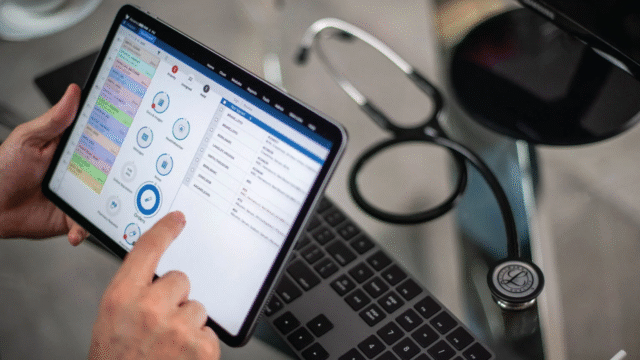In today’s fast-paced healthcare landscape, early detection of disease outbreaks is critical. Whether it’s the seasonal flu, dengue fever, or emerging viruses like COVID-19, identifying trends early can save lives, reduce costs, and help allocate resources efficiently. This is where Electronic Health Record (EHR) data analytics comes into play. By analyzing vast amounts of patient data in real time, healthcare providers and public health agencies can spot patterns, identify risk zones, and act quickly to prevent widespread disease transmission.
In this article, we’ll explore how EHR data analytics works, the technologies behind it, and how it is revolutionizing public health by predicting disease outbreaks.
What is EHR Data Analytics?
Electronic Health Record Software (EHRs) are digital versions of a patient’s paper chart. They contain detailed medical information such as diagnoses, lab results, medications, allergies, visit histories, and demographics. EHR data analytics refers to the process of extracting, processing, and interpreting this vast pool of data to gain actionable insights.
Using data analytics tools often powered by artificial intelligence (AI) and machine learning, healthcare organizations can spot trends and anomalies that may point to emerging public health threats.
Real-Time Disease Surveillance
One of the most powerful uses of EHR analytics is real-time disease surveillance. By continuously monitoring health data across a large population, healthcare systems can identify:
- An unusual spike in fever-related symptoms
- A sudden increase in respiratory infections in a specific region
- Clusters of similar diagnoses in neighboring hospitals
This real-time insight helps public health officials respond faster than traditional reporting methods, which often rely on manual data entry or delayed lab reports.
For example, during the early stages of the COVID-19 pandemic, some healthcare systems were able to use EHR data to flag unexplained pneumonia-like cases days or even weeks before official testing was widespread. This enabled quicker internal responses, isolation measures, and contact tracing.
Geographic Mapping and Hotspot Identification
EHR data is often tied to patient addresses or clinic locations, allowing for geographic mapping of symptoms or diagnoses. When analyzed through GIS (Geographic Information System) tools, this data can highlight disease hotspots.
Public health departments can use this information to:
- Send mobile testing units to high-risk neighborhoods
- Increase awareness campaigns in outbreak areas
- Monitor spread patterns over time
This level of precision helps optimize limited resources and ensures faster containment.
Predictive Modeling: Going Beyond Detection
Beyond detection, EHR data analytics supports predictive modeling. By analyzing past data such as infection trends, seasonal variations, and comorbidities AI models can forecast future outbreaks or patient surges.
For example, during flu season, a predictive model might use current EHR data (like flu diagnoses, symptoms, and prescriptions) to forecast a sharp rise in cases within the next two weeks in a certain region.
This allows hospitals to:
- Stock up on medications and PPE
- Prepare isolation wards
- Alert nearby facilities of possible patient overflow
Predictive analytics also helps determine who is most at risk. By examining underlying health conditions, age, travel history, and other variables, EHR-based systems can identify high-risk individuals and enable targeted interventions.
Integration with National Surveillance Systems
Many healthcare institutions share their anonymized EHR data with national and international disease surveillance platforms. Systems like the CDC’s National Syndromic Surveillance Program (NSSP) in the U.S. and ProMED globally rely on aggregated EHR insights to provide early warnings about public health threats.
The automated nature of EHR data transfer reduces delays and human error, enabling faster and more accurate public health responses. It also encourages data standardization, improving collaboration between institutions and regions.
Challenges and Limitations
While EHR data analytics is a powerful tool, there are challenges:
- Data Privacy and Security: Sharing patient data, even anonymized, raises privacy concerns. Strict regulations like HIPAA (in the U.S.) and similar laws worldwide are essential for ethical use.
- Data Quality and Standardization: Not all EHR systems record data in the same format. Inconsistent entries, missing fields, or different coding practices can hinder accurate analysis.
- Technology Gaps: Not all healthcare facilities, especially in underdeveloped areas, have access to advanced EHR systems or analytics infrastructure.
- Interpretation Bias: Over-reliance on algorithms can sometimes miss the context or lead to false positives if not cross-checked with human expertise.
Despite these challenges, continuous improvements in health IT and machine learning are helping mitigate these issues.
The Future of Outbreak Prediction
As health systems become increasingly digitized, EHR data analytics will only grow more powerful. We can expect:
- Integration with wearable devices: Continuous health monitoring through smartwatches and fitness trackers will feed even richer data into EHRs.
- AI-powered dashboards: Healthcare providers will have real-time visual insights at their fingertips.
- Global collaboration: Unified health data standards will facilitate international efforts to monitor and contain diseases.
In a world where new diseases can spread across the globe within days, predictive health analytics powered by EHRs will become a cornerstone of modern public health strategy.
Final Thoughts
The ability to predict disease outbreaks through EHR data analytics is not science fiction; it’s a current and growing reality. From identifying early warning signs to helping hospitals prepare in advance, this technology has the potential to transform how we manage public health emergencies.
While challenges exist, the benefits far outweigh the hurdles. As more healthcare providers invest in smarter Patient Management Software and real-time data sharing tools, our collective response to outbreaks will become faster, smarter, and more efficient, saving countless lives in the process.







